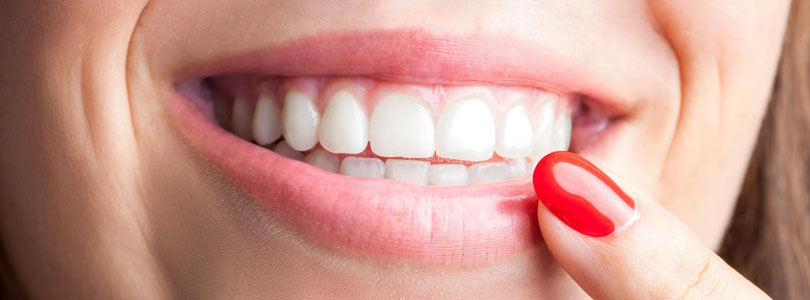

The use of dentures (removable prosthesis) is recommended when the lack of teeth is extensive or if the position of the teeth or the quality of the jaw bone does not allow the replacement of the missing teeth with crowns or bridges.
What problems can missing teeth induce?
- digestive disorders may occur due to reduced chewing ability
- changed shape of the oral cavity may make articulation more difficult
- wrinkles on the face may deepen, as the facial muscles lose their base support
- overall well-being may worsen, inhibitions may develop


What are the benefits of replacing your missing teeth?
- the main advantage is a properly functioning, intact and complete denture
- aesthetic look, perfect smile, which makes you feel better and confident
- younger look and improved well-being/ self-confidence
- ability to chew properly, avoiding any digestive problems
- speech and articulation may be improved due to the proper shape of the oral cavity and teeth
- wrinkles on the face may be reduced or soften in affected areas
- dentures of today have a natural effect, therefore they fit better and are more comfortable, which will allow you feel like having your own teeth
BOOK AN APPOINTMENT AND VISIT US
Prevent or eliminate problems caused by the lack of teeth and smile with confidence:
There are several types of removable prostheses. However, to get a full picture of which suits you the best, one must consider a few factors before:
- Since when have you had missing teeth?
- How many teeth are missing from your denture?
- Have you ever had any teeth replaced before?
- What is the condition of your oral cavity?
Our dentists recommend the most appropriate tooth replacement method based on the answers to the questions above.
Types of dentures and prosthesis


Complete denture
Partial removable denture
Removable prosthesis stabilized on implants (overdenture)
Complete denture
Complete denture is a removable prosthesis that is recommended in case of edentulism (complete toothlessness). The prosthesis is a replacement not only for the teeth but also for the gums.
Parts:
- Base plate: The base plate of the dental prosthesis lies on the base of the mucous membrane and bone. Its stability is ensured by facial muscles, the surface of the mucous membrane and bone, the vacuum effect, chewing pressure and gravity. This base transfers the chewing power to the bone.
- Pink ceramic: The pink ceramic is mounted onto the base plate and helps restore the aesthetics of the oral cavity and face.
- Artificial teeth: Artificial teeth, attached to the denture, help restore the patient’s chewing ability in addition to the above-mentioned aesthetic function.
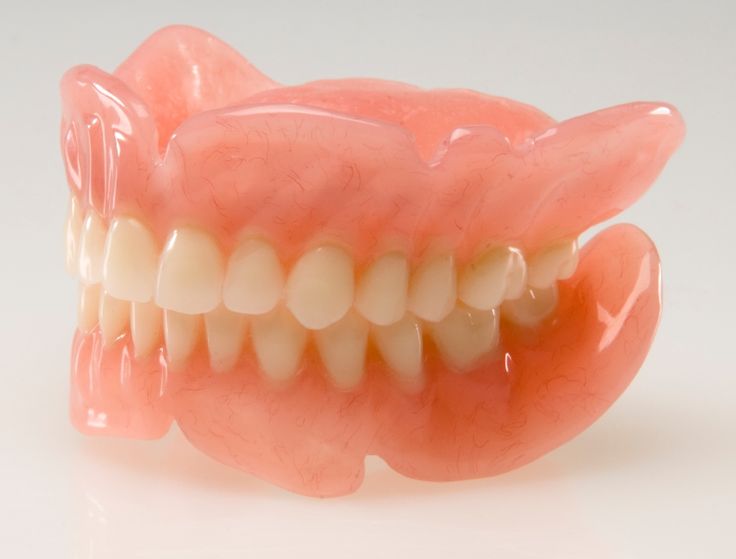

Materials used:
The complete, removable, partial denture is made of special plastic, but it can also be combined with metal parts. As the special plastic can easily be dehydrated, it should always be kept moist so that the original shape of the denture does not deform.
Partial removable denture
This type of denture is recommended if toothlessness is not complete, but the number of existing teeth is no longer sufficient to make fixed replacements. The partial plate prosthesis occupies a larger space than the natural teeth, as it replaces the teeth along with receded bone and the palate.
Parts:
- Base plate: The denture is in contact with the base of mucous membrane and bone. It can be made of metal, plastic or a combination of both.
- Pink ceramic: It is made of a pink material similar to gum colour, its function is to fasten the teeth to the base plate.
- Artificial tooth: Its main function, besides chewing and aesthetics, is to facilitate articulation during speech.
- Special attachments: To fix a denture, we use different clips, pre-manufactured attachments, tippers and supports at the level of chewing surface
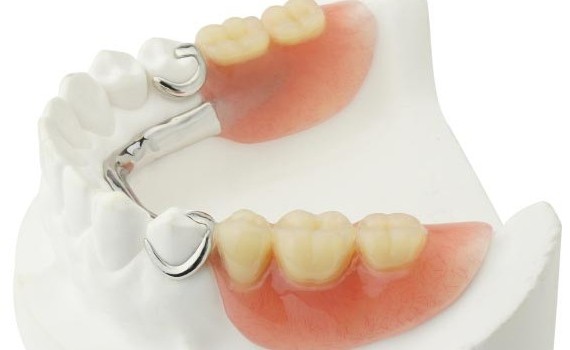

Metal frame denture with special hidden attachments
Our clinic can also provide metal frame dentures with special hidden attachments. In contrast to the partial removable denture, the metal clip is not visible on the outer surface of the teeth and provides a more stable, long term solution.
This type can only be used if there is sufficient number of front teeth, while some teeth in the back area are absent. The removable part is attached to the bridge to make the repair easier when the click part wears off. Hidden special attachments have different types: sliding, bar- or anchor-attached.
Removable prosthesis stabilized with implants
Overdentures or bar supported prostheses
If the patient is edentulous, our dentists, mostly, recommend this type of prosthesis. In most cases we use this for the replacement of the lower denture. Among the denture solutions, this provides the highest stability because it is attached to implants inserted in the jaw with special patents.
Parts:
- Dental implants: usually 4-6 implants are inserted into the jaw
- Special bar and patents
- Dental prosthesis
This method allows us to create a fixed denture that can be removed and placed back by the patient.
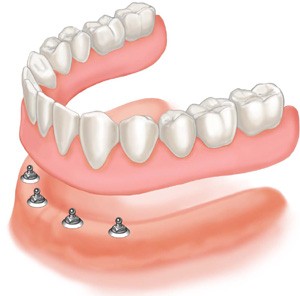

The difference between the complete denture and the implant-stabilized removable denture (overdenture) is that while the complete denture is fixed entirely due to the anatomical conditions of the oral cavity and the vacuum effect, the overdenture prostheses stays in place by being attached to implants. Recently we have been using this method more often, especially on the lower jaw, where achieving the stability of the complete denture is the most difficult.
Certain conditions need to be considered before choosing this option, since not all jaw bones are suitable for implants.
The process of making dental prostheses stabilized on implants is slightly different from that of other prostheses. First, dental implants need to be placed into the jaw as a basis for prosthesis. After a 4-6 months long healing period, the special structures will be mounted on the implants. The ready-made denture fits perfectly to the mounted implants
General procedure for making dentures
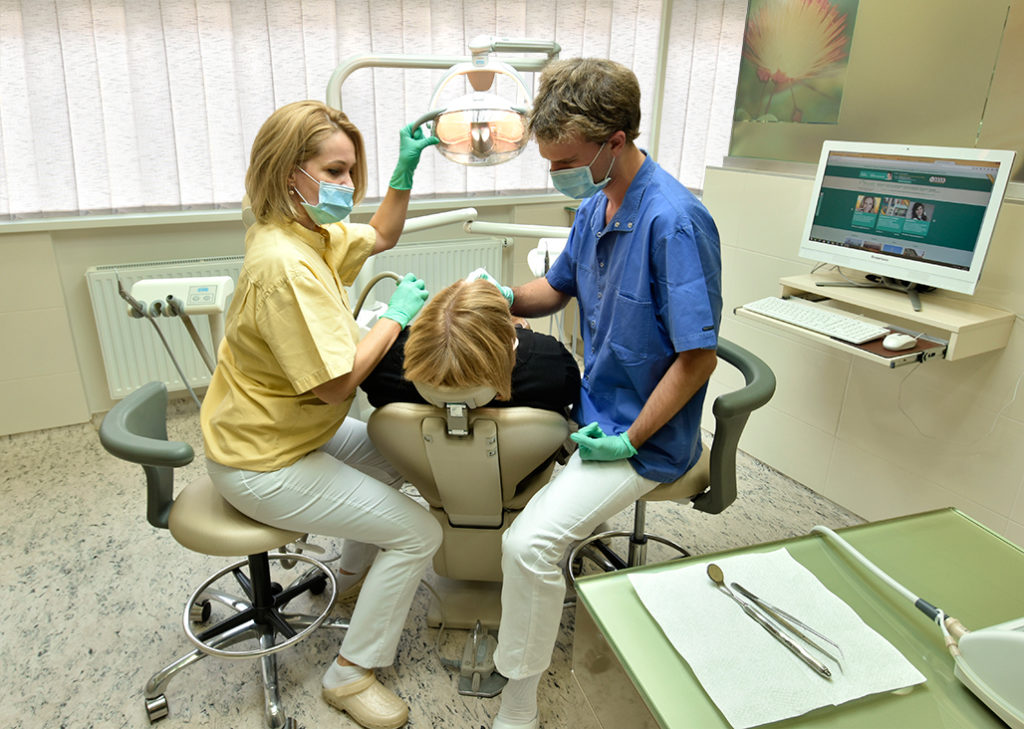

1. Comprehensive dental examination and consultation
During the initial evaluation our dentist and dental surgeon will conduct a full examination of our patient’s teeth. X-rays and/or CTs are made as needed and based on the result of these a treatment plan is formulated. Once the treatment plan is discussed with the patient and finalised, the treatment starts.
2. Impression taking
First, our dentist takes an impression with a special material from the mouth, and palate of the patient, then the most suitable tooth colour is chosen together with the patient. Later, the dental impression is sent to our in-house dental laboratory where our dental technicians fabricate the denture in a few days using high quality materials and the most advanced technology.
3. Adjustments prior to the permanent fitting of the denture
Once our dental technicians have finished making the denture, we call the patient for a try-in session.During the session, our dentist checks whether the denture fits precisely into the mouth, it is comfortable and offers aesthetically the perfect smile the patient desires. Our objective is to make the most suitable denture possible for our patient.
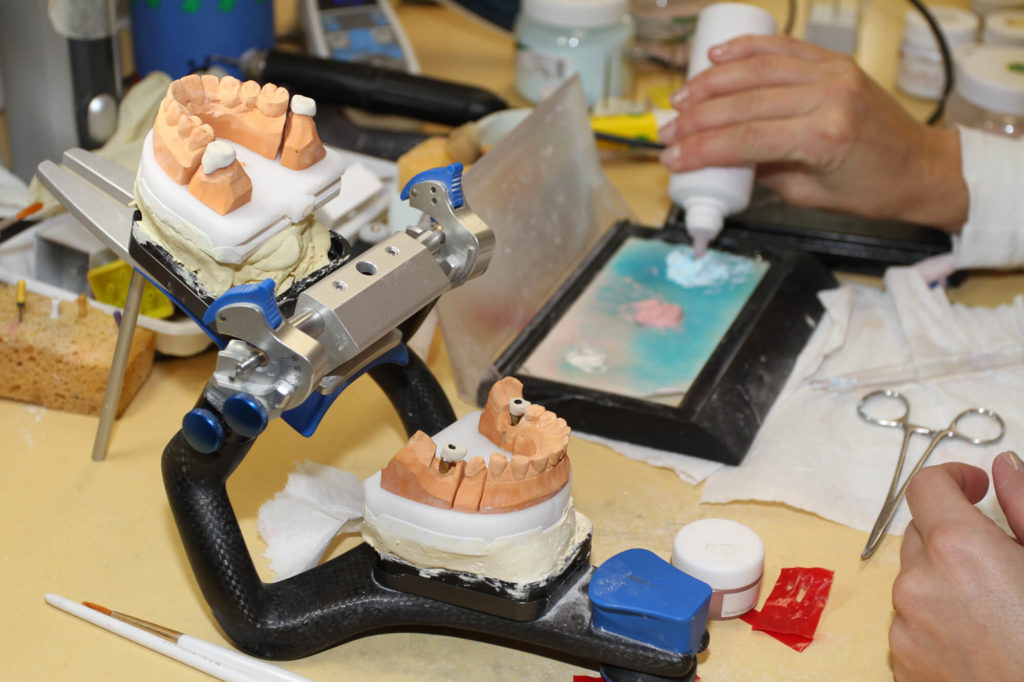

4. Permanent fitting
After final adjustments have been made, our dentist permanently fixes the denture so that our patient can enjoy the new aesthetic and comfortable denture.


What to pay attention to, after the permanent fitting?
- Primarily, one must get used to placing the denture in and out of the mouth and wearing it
- In the beginning it is advisable to eat softer foods concentrating on chewing on both sides, equally loading the jaw.
- You should avoid foods that are hot or may stick into the teeth (candies).
- For a few days, after the permanent fitting you may experience excessive saliva production
If your dentures press onto your gum causing excessive sensitivity, or if the denture has displaced, please visit our clinic as soon as possible.
How to clean your denture?
Just like taking care of our own teeth, we must take enough time to keep dentures clean as well so that they can provide a more complete functioning and a more comfortable life.
- 1. Take your denture out of your mouth and rinse it with warm water.
- 2. Later, clean it with a ’hard’ density toothbrush without leaving any leftover food in the indentations. This process should, possibly, be repeated after each meal.
- 3. It is important to keep your mouth and gums clean too.
- 4. It is recommended to use cleansing solution or tablet, twice a week. This way, plaque,, discoloration and inflammation causing bacteria can be fought off easier and more effectively. Dentures should be rinsed both before and after using cleansing solution or tablet.
BOOK AN APPOINTMENT AND VISIT US
Prevent or eliminate problems caused by the lack of teeth and smile with confidence:
